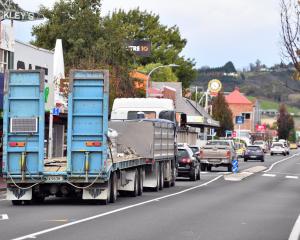The threat caused by the rising sea level means new homes in some coastal areas of Dunedin will have to be built up to 1.2m higher off the ground to reduce the risk of being flooded.
The changes announced by the Dunedin City Council yesterday apply to the floor levels of residential or communal buildings and extensions, but not to industrial or commercial buildings.
The new minimum levels, on average 75cm above the previous level, do not apply to South Dunedin because of the protection provided by sand dunes and the way the area has been developed.
The previous level was 2.15m above the mean sea level in Dunedin measured in 1958 and 29mm above the previous highest recorded tide in Dunedin in March 1980.
About 7000 properties close to coastal areas have some, or all, of their land below the new minimum floor level, of which 5400 are in South Dunedin where the existing rule will still apply.
The new levels apply to 1560 coastal properties, mainly in and around harbour towns, of which just under 1000 are in residential or communal use.
The change also meant flood warnings were yesterday added to properties in coastal parts of Dunedin, including South Dunedin, which Cr Kate Wilson said had potential to affect both property values and insurance costs.
The information, added to Land Information Memorandums (LIMs) yesterday, warned owners and purchasers houses below the new minimum levels could be subject to increased flooding risk over the next 50 years "from elevated sea-level rise associated with climate change".
The new levels ranged from 45cm above the previous levels in the upper Otago Harbour to 1.2m above in the suburb of Brighton.
Cr Wilson said at a media conference yesterday the change could have a "dramatic" effect on people wanting to build homes or extensions in low-lying areas.
"It's a relatively small number of properties in Dunedin, but it will affect some people quite dramatically."
Asked if the council had looked into how much extra it might cost to build on affected properties, she said: "The focus has been on how we can protect that investment, rather than how much it would cost them, because it would cost them a much greater amount if they had a property that was likely to be flooded."
The message was that if you were investing in these areas "you need to look at this issue".
Dunedin Mayor Dave Cull said the council, along with "all coastal councils", had a statutory obligation to include the warning on LIMs under the Local Government Official Information and Meetings Act.
Council operations general manager Tony Avery said the changes were based on predicted sea level rises, a report on floor levels by engineering company MWH provided to the council last year, with differences in local areas based on an Otago Regional Council report looking at vulnerability to elevated sea levels.
The changes had implications for applications for building consents, resource consents, subdivision consents and could result in district plan changes, he said.
The changes were just the start of the council's response to the threat of sea level rises.
"There are some big questions we are unable to answer at the moment, but we are taking a precautionary approach," he said.
Real Estate Institute of New Zealand Otago regional director Elizabeth Nidd said she did not think the changes would have a major effect on property prices.
"In most situations, people are going to be aware [of the risks] anyway, so it's kind of a statement of the obvious.
"It's just another small hurdle for us to get over," Ms Nidd said.
Insurance Council spokesman Chris Ryan said having the new information included on LIMs would be "unlikely" to affect insurance prices "in the next year or two", but could in the longer term.
Otago Master Builders Association president Mark Ward said the cost of the minimum floor height standards would likely be small and depend on the location and design of the house.
"It will probably add to the cost of build a little bit, but not much," Mr Ward predicted.
The change would be more difficult for people wanting to build extensions in low-lying areas.
"It will be difficult and dopey, because you wouldn't want to walk up three flights of steps to get to your bedroom."
It could also add stress for people part way through designing extensions or new houses, but yet to apply for consent.
"It could cause a bit of chaos. I mean if you were building a house right by the sea, you might have to redraw your plans."
Waikouaiti Coast Community Board chairman Gerard Collings said while he understood some people living in coastal areas could be annoyed by the changes, it would be "negligent" of the council not to make the information available to prospective buyers.
"My feeling is that it's prudent for council to signal and clearly enforce an appropriate floor level," Mr Collings said.
Saddle Hill Community Board chairman Keith McFadyen said he was keen to discuss the changes with residents and the issue would be discussed by the community board.
ORC chairman Stephen Woodhead said it supported the move by the council.
"We support their endeavours to use the latest information for building control and planning purposes," he said.
Although the Waitaki District Council was aware of the issue, there were no plans for height restrictions in the district.
However, council planning manager David Campbell said the resource consent procedure for coastal areas already addressed the situation in a secondary way, as flooding hazards were covered in the district's coastland landscape plan, although it was primarily intended to protect landscape.
The situation would be reviewed as part of district plan procedure in two years' time, he said.
Raising floor height*
- Brighton (all coastal land south of Blackhead)120cm
- Coastal peninsula area (Hoopers Inlet etc)75cm
- Upper Otago Harbour55cm
- Karitane, Flag Swamp and Waikouaiti50cm
- Long Beach, Aramoana, Purakaunui, Port Chalmers, Sawyers Bay, Harwood, Warrington, Blueskin Bay45cm
*height is above previous minimum floor height












